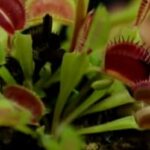As an Amazon Associate, this site earns commissions from qualifying purchases. For more details, click here.
One of the most common questions that new pitcher plant owners ask is how much to feed them. Is once a month okay, or should that be once a week? Do these plants really need to be fed or can they live without eating bugs? Because feeding is a source of nutrition, knowing how much to give the plant is important.
You can feed indoor pitcher plants once a week. You can use ants, gnats, flies, fish food and mealworms. Outdoor pitcher plants do not need to be fed because there are many insects around them.
How Much Should I Feed My Pitcher Plant?
You have probably heard people feed nepenthes once a month. Yet others nourish their plants once a week. Some feed just one pitcher while others drop food in several of them. Which is correct?
Pitcher plants should eat at least one bug a month. You can however, feed up to three pitchers a week. Do not put human food in the pitchers or any prey that can chew the leaves.
If you are not sure how much food to give, start with once a month. After a few weeks, you may increase it to twice a month and then once a week. This is the maximum number of times you should feed pitcher plants. You can do this not just with bugs but also other food including Ultra Fresh Betta Fish Food.
You can feed multiple pitchers for monthly or twice weekly feeding. If the plant eats once a week, feeding one pitcher should be enough.
Frequent feeding can help pitcher plants grow, but it is not necessary for their survival. These plants create their own food through photosynthesis so they can live without eating bugs. However, these bugs provide nutrients which help the plants grow faster.
How to Feed Pitcher Plants
The following is a step by step guide to feed pitcher plants. It is a really simple process and even a new plant grower can do it.
- Decide what food to give. You can choose from flies, gnats, spiders and other small insects. Mealworms, blood worms, fish food or a few drops of Maxsea fertilizer.
- To feed insects. Just drop the bug into the pitcher. Use tweezers to grab the food if necessary. You can use live or dead insects.
- To feed fish flakes or other fish food. Sprinkle a bit of the flakes into the pitcher. For other fish food, add a few drops of water.
- Pitcher plant soil should never be fertilized, but you can put heavily diluted Maxsea on its leaves. To feed with Maxsea fertilizer. Dilute 1/4 teaspoon fertilizer in a gallon of water. Place a few drops into the pitcher.
Repeat the steps for each pitcher you want to feed. Again, most nepenthes and sarracenia will be fine even if just one pitcher is given food.
Start by feeding one pitcher and wait a couple of weeks before feeding again. If the plant looks line, repeat after two weeks. You can stay with this schedule or do it once a week.
If you are feeding multiple pitchers, check them regularly. If the plant is digesting the bugs, keep going. But if most of the insects are still in the pitcher or starting to rot, reduce the feeding frequency. This means your pitcher plant is already getting enough nutrition.
Do You Have to Feed Pitcher Plants?
If your pitcher plants are outdoors, do not give them any food. There are many insects available which will provide all the nutrients they need.
Sarracenia and nepenthes produce nectar to entice prey. The nectar is spread around the pitchers, giving them a sweet scent. If your pitcher plant is outdoors, bugs will be drawn to the trap when they smell it.
Indoors you have to feed the plant because it has little access to insects. But these bugs can get to the nectar if the plant is outdoors, so you do not have to do any feeding.
Once a bug lands on a pitcher, the trap is set. The moisture causes the bug to fall into the pitcher and liquids inside it prevent the bug from getting out. Some nepenthes rely on water droplets as their leaves vibrate when stuck by water, hurling any insect on the leaf into the pitcher.
This is why outdoor pitcher plants do not require any help feeding. They are perfectly capable of attracting inscts, catching and eating them. Once caught, digestive juices melt the insect so it can be consumed and converted into essential elements.
What to Feed Pitcher Plants
You can feed almost any small insect including flies, gnats, crickets, mosquitoes, moths, grasshoppers, ladybugs and more. Mealworms, bloodworms and butterflies, fish flakes and fertilizers are good options too.
You can feed live, dead or freeze dried bugs. You can buy insect food online or in various pet stores so supply is not a problem. If you keep your pitcher plants indoors, finding them insect food will not be a problem.
In terms of nutrition, mealworms, bloodworms and fish food are as good as insects. As far as fertilizer goes, use Maxsea as it is proven safe. Again, dilute it first before giving to the plant. The typical ratio is 1/4 teaspoon fertilizer per 1 gallon of water.
Nepenthes and sarracenia only need a small amount of food nutrients. Once a month will be enough to ensure its growth as long as there is enough light, water, humidity and the right soil. If your plant grows in a suitable environment, infrequent feeding is fine. With photosynthesis, pitcher plants can produce glucose for food.
What Not to Feed Pitcher Plants
Do not give sausages, hamburger, eggs, chicken, chocolate, bacon, nuts, pasta, rice, donuts or fruits to pitcher plants. Do not put mice, frogs or other large animals in its pitcher. As a rule, anything other than a small insect should be avoided.
Do not feed human food to pitcher plants. They are not capable of digesting those, and forcing them to eat it may cause pitchers to turn black and die.
You may have seen nepenthes plants eat frogs, mice and other animals in the wild. If the pitcher is large enough then yes, the plant can digest them. But this happens rarely. Trapping and digesting prey requires a lot of resources, and eating large animals regularly could drain the plant.
Tips For Feeding Pitcher Plants
Feeding pitcher plants is easy, and if outdoors the plant can fend for itself. But there are things you can do to make feeding even better and more effective.
- Do not fill the pitcher with food. The plant will only eat what it is capable of digesting, and excess food will just decompose and cause a stink.
- Watch for any adverse reaction to what you give it. Pitcher plants may react different to various foods. Some may handle fish flakes better than others. If you are introducing new food, feed only small amounts. Look for any changes in the next couple of weeks. If everything looks fine, keep feeding. if the leaves turn brown, stop giving it that stuff.
- Do not feed pitchers if there is no liquid inside them. The plant needs liquids to digest prey. If the pitcher is devoid of fluid, increase humidity around it.
- Do not put any fertilizer in the soil. Feeding its leaves with a bit of Maxsea is fine.
- Do not spill food in the soil. Remove any food that gets spilled immediately. .
- If the pitcher plant only eats once a month, that is all right. As long as its leaves are healthy there is nothing to worry about.
- Some pitcher plants go dormant. During this time the plant discards its leaves and stops eating. This is normal. Wait until spring when the plant will rise again. When it does, you can start feeding it again.
Conclusion
As you can see there are a lot of different ways to feed pitcher plants. Which method you use depends on your personal preference and the plant itself. As long as you follow the guidelines here, there should be no issues.

My fascination with carnivorous plants began many, many years ago with Venus Fly Traps. Now I am more than happy to impart what I know with other enthusiasts and those who are curious about meat eating plants.



